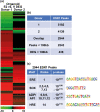The Estrogen Receptor α Cistrome in Human Endometrium and Epithelial Organoids
- PMID: 35895287
- PMCID: PMC9368022
- DOI: 10.1210/endocr/bqac116
The Estrogen Receptor α Cistrome in Human Endometrium and Epithelial Organoids
Abstract
Endometrial health is affected by molecular processes that underlie estrogen responses. We assessed estrogen regulation of endometrial function by integrating the estrogen receptor α (ESR1) cistromes and transcriptomes of endometrial biopsies taken from the proliferative and mid-secretory phases of the menstrual cycle together with hormonally stimulated endometrial epithelial organoids. The cycle stage-specific ESR1 binding sites were determined by chromatin immunoprecipitation and next-generation sequencing and then integrated with changes in gene expression from RNA sequencing data to infer candidate ESR1 targets in normal endometrium. Genes with ESR1 binding in whole endometrium were enriched for chromatin modification and regulation of cell proliferation. The distribution of ESR1 binding sites in organoids was more distal from gene promoters when compared to primary endometrium and was more similar to the proliferative than the mid-secretory phase ESR1 cistrome. Inferred organoid estrogen/ESR1 candidate target genes affected formation of cellular protrusions and chromatin modification. Comparison of signaling effected by candidate ESR1 target genes in endometrium vs organoids reveals enrichment of both overlapping and distinct responses. Our analysis of the ESR1 cistromes and transcriptomes from endometrium and organoids provides important resources for understanding how estrogen affects endometrial health and function.
Keywords: chromatin; endometrium; estrogen receptor.
Published by Oxford University Press on behalf of the Endocrine Society 2022.
Figures





References
-
- Mazur EC, Large MJ, DeMayo FJ. Chapter 24 - Human oviduct and endometrium: changes over the menstrual cycle. In: Plant TM, Zeleznik AJ, eds. Knobil and Neill’s Physiology of Reproduction. 4th ed. Academic Press; 2015:1077-1097. doi:10.3390/ijms21082815 - DOI
Publication types
MeSH terms
Substances
Grants and funding
LinkOut - more resources
Full Text Sources
Other Literature Sources
Miscellaneous

